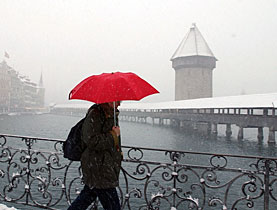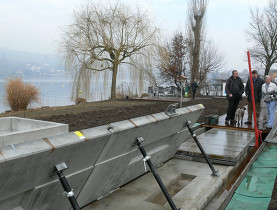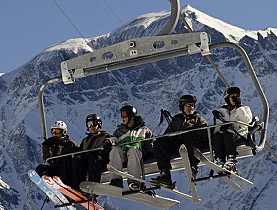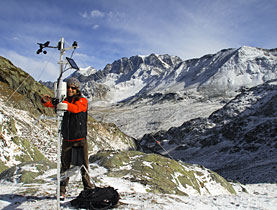Snowmen dying out in town gardens

Winters have almost disappeared in the low-lying areas of Switzerland where most of the population lives.
Since 1988 the number of “snow days” in the plateau has gone down by over half, according to a study published in the science magazine Geophysical Research Letters on Wednesday.
Some of the lowest-lying towns have had fewer than ten days of snow in the months between December and March in the past 20 years. South of the Alps, which is drier than the area to the north, there was on average less than one week of snow per winter, at an altitude of between 200 and 800 metres.
It is the first time that the snow days at this altitude have been investigated, the report’s author, climatologist Christoph Marty of the Swiss Federal Institute for Snow and Avalanche Research in Davos (SLF), told swissinfo.
Researchers recorded the number of days in which the snow was deeper than a given threshold. In the plateau (defined as the altitude between 200 and 800 metres above sea level) this threshold was set at five centimetres – the amount required for a typical winter activity in the area, such as building a snowman.
Impact on tourism
It has been known for some time that winters have been getting warmer, but the research has thrown new light on the process.
“My findings are that the most dramatic retreat is on the Swiss plateau, but we also have a decline in snow days at the upper altitudes. Even at an altitude of about 800 metres the decline is 20 per cent,” Marty said.
The most obvious immediate impact will be on winter tourism – and not only because the lower resorts lack snow.
“If the places where people live do not get a winter feeling, there is less reason to go skiing, because maybe you have problems to imagine that there are even places in the Alps where there is enough snow to ski,” Marty believes.
Another unexpected finding of Marty’s research was that the decline in snow days has not been a steady process, but seems to occur in steps.
“For the 40 years from 1948 to 87 we have a relatively constant level of snow days. And at the end of the 80s we have a drop and since then it’s again been more or less constant.”
Analysis of data from Italy, Austria, Germany and France indicates that similar patterns are to be found elsewhere in Europe, he said.
Flood warning
He explained that the change in temperature is the same at all altitudes, which means that a rise of one degree on the plateau has a greater impact than it does higher up, because the temperature at low altitudes is already around melting point.
The fact that the temperature on the plateau hovers around the melting point of snow has important knock-on effects given that the amount of precipitation has remained the same.
“In the plateau we have always had a lot of variation, but the variation has now decreased because we have more and more winters with no snow,” Marty explained.
“Maybe the biggest effect is that if in the future the precipitations no longer fall as snow there is a higher probability of floods in the winter – and that is what climate models are also forecasting.”
And as temperatures rise, the altitude at which rain replaces snow will rise too.
Although at certain points in history it is known that temperatures were higher than they are now, Marty does not believe that the phenomena he has observed are simply part of a cyclical process.
“Theoretically it is possible, but the probability is very low if we believe in climate change and we know about greenhouse gases. We know it takes about a thousand years before the effect of the greenhouse gases is more or less eliminated.”
His advice is unequivocal.
“The only thing we can do is to emit less greenhouse gases. We know we can’t do anything about the next 20 years because what will happen regarding warming during the next 20 years is already in the air.
“We can just try to ensure that there is no more effect for the 20 years after the next 20 years.”
swissinfo, Julia Slater
Christoph Marty’s research was based on records from 34 weather stations between 200 and 1,800 metres above sea level going back for at least 60 years.
Despite regional differences, all indicated that the past 20 years have had an unprecedented number of low snow winters.
At all altitudes, an abrupt change occurred in the winter of 1988 or 1989.
The abrupt change was detected not only at city stations but also in the countryside and in the mountains.

In compliance with the JTI standards
More: SWI swissinfo.ch certified by the Journalism Trust Initiative



You can find an overview of ongoing debates with our journalists here. Please join us!
If you want to start a conversation about a topic raised in this article or want to report factual errors, email us at english@swissinfo.ch.